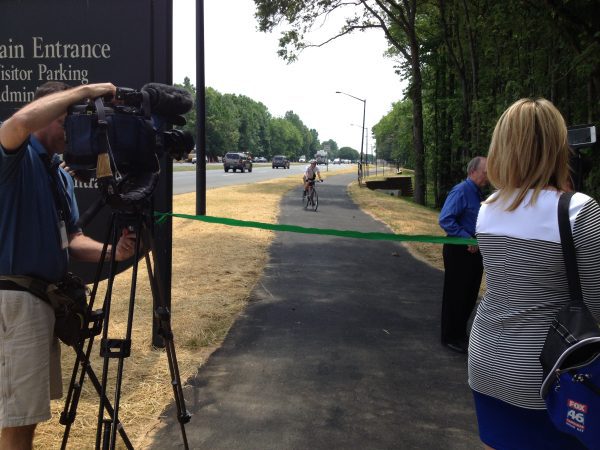Another step for pedestrians on one of city’s least-walkable streets

A 10-foot-wide asphalt path that officially opened Tuesday offers a glimpse of what could be a more pedestrian- and bike-oriented future for some of Charlotte’s least pedestrian-friendly thoroughfares.
The path, 0.9 miles along University City Boulevard from Mallard Creek Church Road to UNC Charlotte’s main entrance at Broadrick Boulevard, is the first bike-ped trail along what Charlotte’s Complete Streets program classifies as a parkway – the city’s most auto-oriented type of street.
A sidewalk and on-street bike lanes were originally planned for that segment of University City Boulevard (N.C. 49), said Scott Correll, pedestrian program manager with the Charlotte Department of Transportation. But because that stretch of the boulevard has a lot of traffic, and much of it high-speed, the trail was a better option since it separates bicyclists from motor vehicle traffic, Correll said. While the Complete Streets program calls for bike lanes and sidewalks on most streets, parkways are an exception.
“Over time, you’ll start to see (trails) on other parkways,” says Correll.
Retrofitting what was originally a rural and then a suburban highway can be costly. The 0.9-mile project cost about $1 million, including staff time. The path required three retaining walls, City of Charlotte project manager and engineer Troy Eisenberger said. A Congestion Mitigation and Air Quality Improvement grant from the Federal Highway Administration and N.C. Department of Transportation paid $400,000. The city’s 2010 Transportation Bond package paid $550,000. UNC Charlotte contributed $50,000 for bricks and other improvements to conform with the university’s main entrance design.
UNC Charlotte’s enrollment in the most recent academic year was more than 26,000 students. Planners and officials expect even more growth once the LYNX Blue Line Extension light rail is complete on the North Tryon Street side of campus in 2017. Three large apartment complexes – the 546-unit Circles at University City, the 300-unit University House Apartments and the 244-unit Millennium One development – are scheduled to open along the new trail’s path this fall, according to a recent economic development report from University City Partners.
“It’s funny how people who haven’t been to this side of town in a while are surprised at how big a campus we have here,” UNC Charlotte Landscape Architect Peter Franz said. “This will help integrate us with the surrounding community. The goal is to get a network of bike lanes that reach out to the apartment locations. It’s just more sustainable in the long run.”
Eventually, officials said, the trail could become part of the proposed Cross-Charlotte Trail, a 26-mile trail that would use existing trails to connect south Charlotte with University City. The city plans a second phase of the University City Boulevard trail, stretching south from the UNC Charlotte main entrance to the Toby Creek Greenway entrance at East W.T. Harris Boulevard. That phase is not funded, and Eisenberger said it’s likely to be costlier because of tougher terrain.
The new trail is already well used. During a short ribbon-cutting ceremony Tuesday afternoon, a bicyclist and jogger maneuvered around the podium where city and university officials were speaking, and headed north toward the half-finished apartment complex on the horizon.